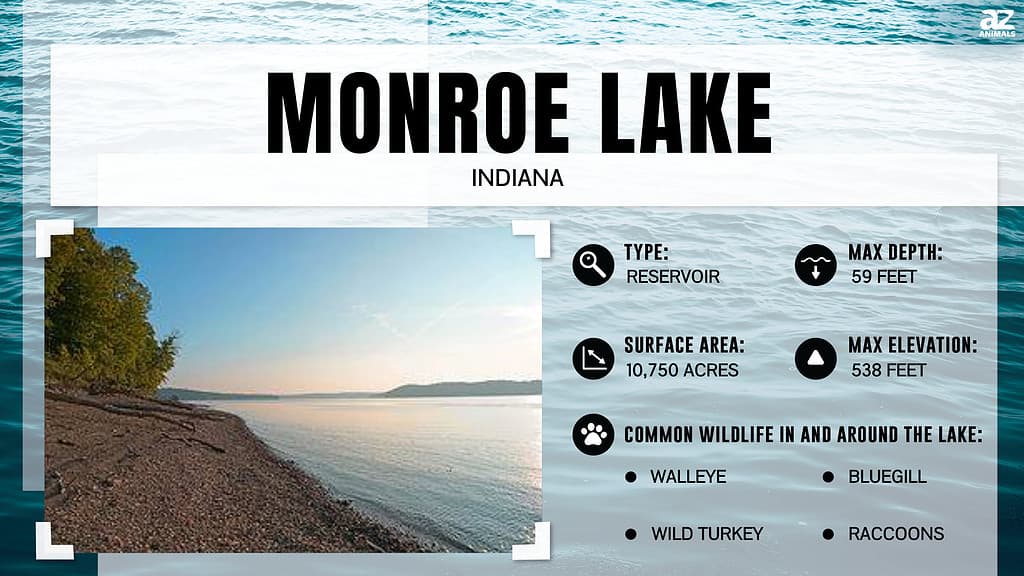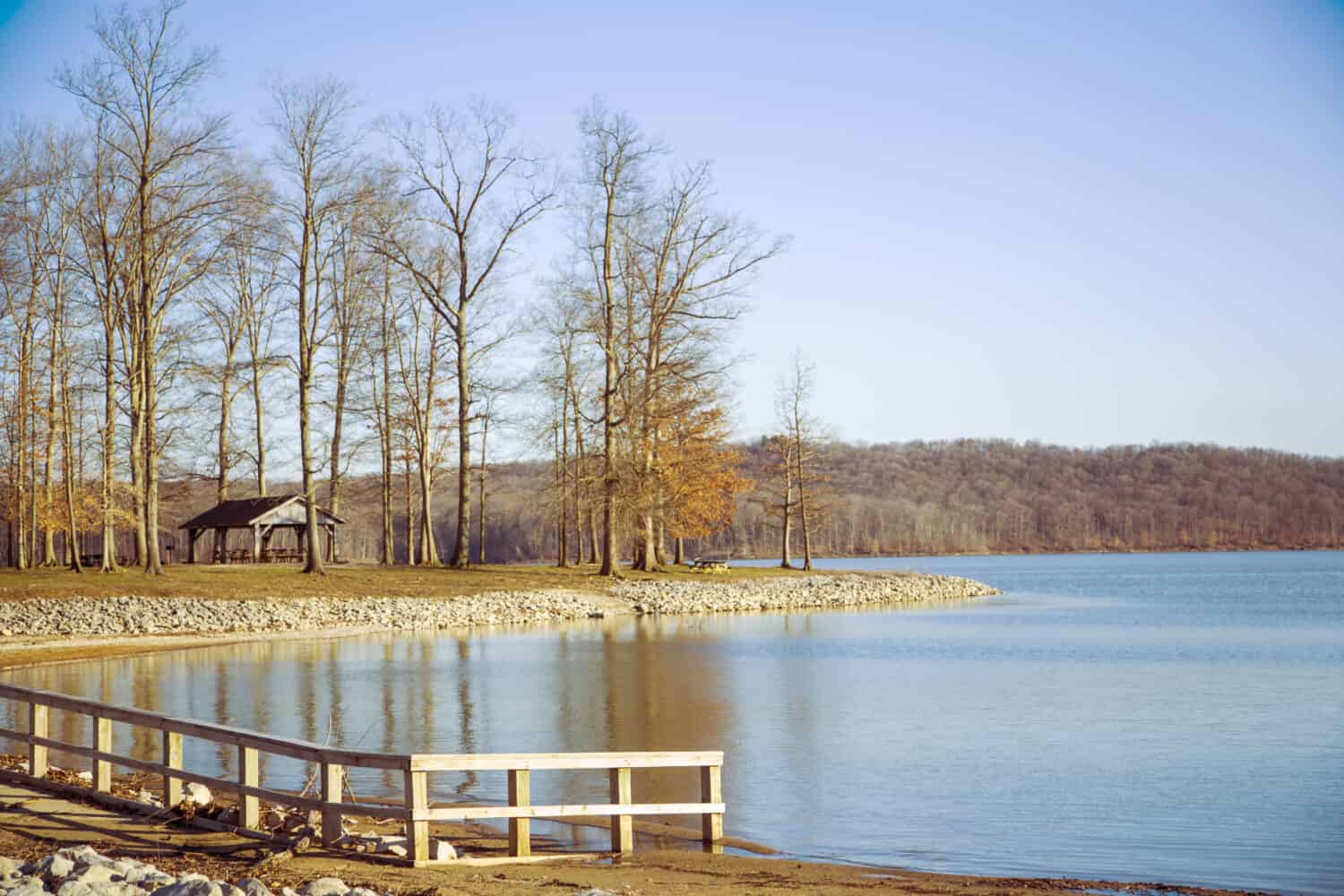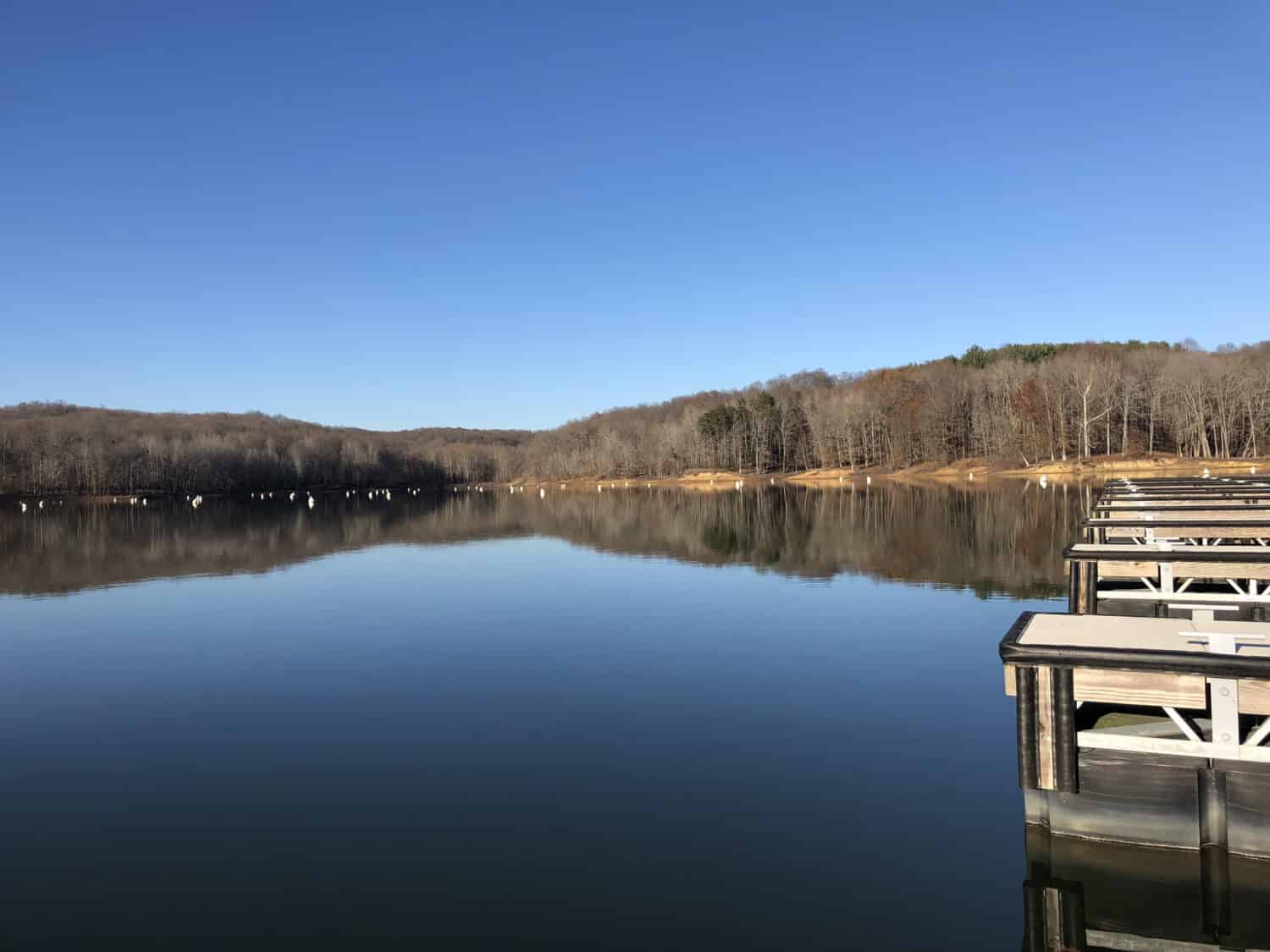There are many natural lakes all over the world, but how many artificial lakes can you name? Trick question, right? In the United States alone, 53,000 lakes are not natural. Yes, around 48% of America’s lakes are artificial.
There are 86 different lakes in the state of Indiana, with the vast majority of them being artificial. The one we are talking about today is Monroe Lake, the oldest artificial lake in the state. Also known as Lake Monroe or Monroe Reservoir, it features interesting origins.

What is an Artificial Lake?
An artificial lake is usually built for the storage of water for community purposes. It includes every body of water that may or may not carry potable water. Potable water is defined as drinking water treated to meet consumption standards.
This body of water can either be permanently filled or may have a source of getting refilled by relevant authorities from different sources. Mostly, it is designed to help enhance the landscape, provide a scenic purpose, or serve the community by aiding in recreational activities.
However, you must note that it does not include swimming pools or water parks. So you cannot go on calling every swimming pool near you an artificial lake. A few examples that you can consider are reservoirs, ponds, lagoons, and of course, our main topic of conversation, lakes.
Monroe Lake is one such artificial lake located in Indiana. Let’s take a boat ride down its history to know more about its origin.

Lake Monroe is the oldest artificial lake in Indiana.
©Adrian Ashwah/Shutterstock.com
How Old is Monroe Lake – Indiana’s Oldest Artificial Lake?
You might know about its history from the 1960s. That’s when Monroe Lake became a star on the map. But its story starts a little earlier than that. In the 1800s, the government built Indiana’s Old Dam. This made way for a small lake that accumulated near the dam and was used for navigation until the 1900s.
The real story started in the year 1960 when its construction took flight. The project took nearly 5 years to complete, and Monroe Lake stood in its complete glory by the year 1965. It cost the government around 16.5 million dollars.
The construction took place to avoid flood damage down the stream and provide a decent water source to the neighborhood cities. Today, Monroe Lake does more than prevent flooding. It is a must-visit attraction for people all over the country.
What Is Lake Monroe Like? How Deep Is It?

Monroe Lake is ten miles outside of Bloomington, Indiana.
©Dawson Tang/Shutterstock.com
Now that you know its origins, let’s talk about how Monroe Lake appears to visitors. First, if you ponder over the lake’s size, it spreads out at a huge 10,750 acres of land and covers about 190 miles of shoreline. It stands 538 feet above sea level and is around 35 to 40 feet deep. It makes the perfect spot for diving and boating.
The lake has a funny shape as it resembles somewhat a Chinese dragon. At the lake’s southern end, the dam stands tall and hosts a safe place for securing boats, as you may call boat mooring. At the eastern end, the lake is a bit shallow. Many inlets provide the necessary protection against the incoming waves of the large lake.
An interesting thing about Monroe Lake is its peculiar shape and its exposure to steep hillsides on private lands. You will find that around 45.8% of its watershed is exposed from the North Folk of Salt Creek, 43% from the Middle and South Forks of Salt Creek, and greater than 12% from Brummet’s Creek and Stephen’s Creek.
A watershed is an area of land that helps direct the water into a smaller or larger stream. All in all, it drains water from one body to another, as you might have seen with different lakes and rivers. For Lake Monroe, the watershed area is around 441 square miles. The water drains from this watershed area, goes straight to Salt Creek, and spreads to different regions like Monroe, Brown, Lawrence, Jackson, and Bartholomew.
It may vary with each season if you talk about how much water it holds. Since the summer calls for an increase in water levels, you might observe the same for this lake. However, with climate change, the statistics may differ. Lake Monroe, on average, holds about 292 to 428 gigaliters of water depending upon various factors, mainly the season and the surrounding temperature.
What Can You Do at Lake Monroe?

The oldest lake in Indiana, Monroe Lake, includes several beach areas.
©Shannon VanB Photography/Shutterstock.com
Now you know the lake’s basic physical attributes, let’s dive into its main attractions. Yes, we are talking about the reason for its popularity, the recreational activities. Monroe Lake offers a whole experience for visitors. People of all ages can enjoy time out here. Here are some of the things that you can do at the oldest man-made lake in Indiana.
Boating
Monroe Lake should be on your list if you are a fan of taking your boat out. With 9 easy-to-launch ramps, you can let your boat out on a fine summer afternoon without any hassle. Paynetown Boat Ramp is by far the most popular out of all and finds many visitors in its vicinity.
Plus, it is not just boats that you can slide into the water. You can also opt for canoes, jet skis, kayaks, and even wakeboards. Six boat-renting facilities are situated at the lake to help you pick the best boating equipment for the day.
- Paradise Rental Boats
- Lake Monroe Boat Rental Inc.
- The Dam Boathouse
- Two Herons Marina
- Fourwinds Lakeside Inn & Marina
- Lake Monroe Sailing Association
You can book the watercraft for a few hours, overnight rentals, or even a 3-day possession at different rates. Their offices are usually open from 9 a.m. to 5 p.m.
Beach Recreation
Lake Monroe is so big that there are three beaches spread out along its area. You will find many people coming out to take sunbathe, play volleyball, or even build sandcastles. If you wish to take a swim in the deep waters, you can do so without any fear. Lifeguards are often present on duty to help you out if things go a bit haywire.
Fairfax Beach, Hardin Ridge Beach, and Paynetown Beach are the three beaches. Fairfax Beach is the largest out of the three. Almost all of them have picnic spots available that may or may not be covered. You can take your pick based on the crowds and different recreational activities present.
Hiking
It is not just about the water at Lake Monroe. If you are up for it, you can even plan a hike with your friends and family. There are various trails near the lake which are around 1 to 20 miles. You can choose any depending on your stamina and the nearby views.
Some of the popular trails are Tower Blackwell Lake via Tower Ridge Road, Lake Monroe via Grubb Ridge Loop and Peninsula Trail, Patton Cave via Grubb Ridge Loop, Lake Monroe via Cope Hollow Trail and Grubb Ridge Loop, Lake Monroe via Grubb Ridge Loop, Amy Weingartner Branigan Peninsula Preserve Trail, Sycamore Trail, and the Tecumseh Trail to name a few.
If you are looking for treks, consider these:
- Tree Trek Trail at the Paynetown State Recreation Area – 0.5 miles
- Whitetail Trai 1 at the Paynetown State Recreation Area – 1 mile
- Turkey Trot Trail at the Allen’s Creek State Recreation Area- 1.9 miles
- Pate Hollow Trail System at the Paynetown State Recreation Area – 6.7 miles
Fishing
Fishing is just as popular as other recreational activities at Lake Monroe. You can find fish of different varieties when you set sail here. In addition, there is no restriction to fishing, you can fish all year long without worry. The popular spots at the lake are Crooked Creek Ramp, the Cutright State Recreation Area, and the Pinegrove Ramp.
It is always a delight to capture a fish on your own. Here are just some of the species you can hope to find and get a picture with later: walleye, bluegill, yellow bass, black crappie, white crappie, flathead catfish, and hybrid stripers.
Camping
If you plan to camp out near the lake, you will find plenty of spots to give you company. The best part is that there is not just a plain area for tent sites; you can also drive up your trailer to the lake and set camp.
The popular camping sites are the Hardin Ridge Campground, Lake Monroe Village, Paynetown Campground, and Yogi Bear’s Lake Monroe Jellystone Park. These sites have water hookups, electricity, swimming pools, playground, and much more. More than 500 forested campsites are available for reservation. However, some sites may be booked on an immediate basis.
Hunting
There are a few hunting spots present near the lake too. However, like fishing, hunters must get a permit before crashing out at the designated sites for a hunt. You can pick your game as there are a bunch of animals out in the forest. Some of them are turkey, waterfowl, and deer. It is a great hunting spot during the holidays!
Vacation Spots
If you are looking for a longer stay near the lake, many hotels and rentals are available to give you company. You can book a room at the Scenic View Lodge or the Fourwinds Lakeside Inn & Marina. Moreover, there are many Airbnbs available as well if that’s your preferred version of staying overnight.
Other Recreation Areas
Many other sites offer different entertainment points for visitors. You can take refuge there if outdoor vacationing is not to your liking. They are the Salt Creek State Recreation Area, Pine Grove Recreation Area, Paynetown State Recreation Area, Hardin Ridge State Recreation Area, Fairfax State Recreation Area, Cutright Recreation Area, Crooked Creek Recreation Area, and Allen’s Creek State Recreation Area.
You will find trails, tennis courts, mini-golf sites, picnic areas, amphitheaters, cabins, marinas, shelter houses, and even playgrounds as these recreational areas.
Hoosier National Forest
Lake Monroe also hosts a forest known as the Hoosier National Forest. It is spread out at 202,814 acres near the Allen’s Creek State area. The forest itself is larger than the whole area of Lake Monroe.
Nonetheless, you can explore the wildlife out here and see the flora yourself as it blooms under the open sky. You and your binoculars will be busy while out here, from raccoons, possums, and coyotes to over 200 bird species. As for flora, you will find many oak trees and wildflowers as you walk through the green forest.
Where Is Lake Monroe Located on a Map?
Lake Monroe is located 10 miles southeast of the city of Bloomington, Indiana. It’s the largest lake in that state, covering 10,750 acres. It stretches across parts of both Monroe and Brown Counties.
The photo featured at the top of this post is © Adrian Ashwah/Shutterstock.com
Thank you for reading! Have some feedback for us? Contact the AZ Animals editorial team.






